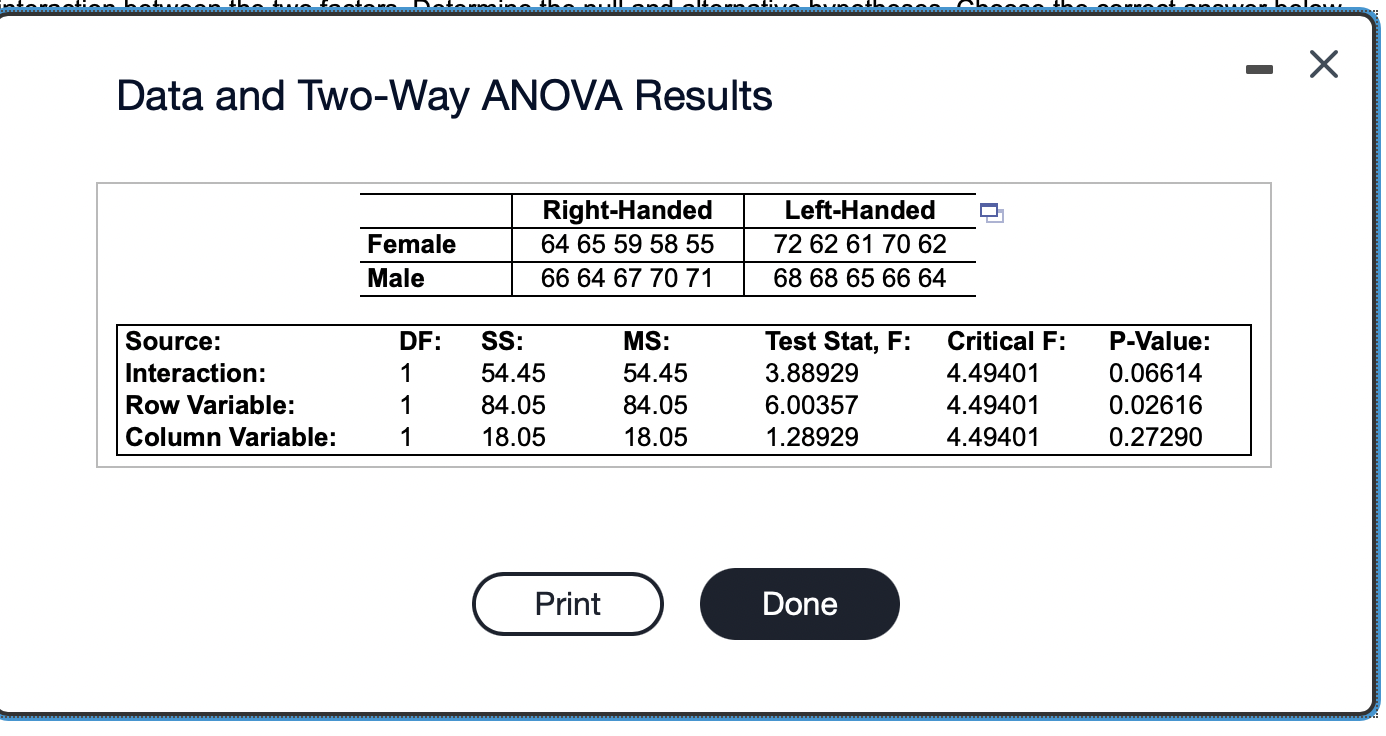Home /
Expert Answers /
Statistics and Probability /
data-and-two-way-anova-results-data-and-two-way-anova-results-the-p-value-is-round-to-t-pa703
(Solved): Data and Two-Way ANOVA Results Data and Two-Way ANOVA Results The P-value is . (Round to t ...
Data and Two-Way ANOVA Results
Data and Two-Way ANOVA Results
The -value is . (Round to three decimal places as needed.) (Round to three decimal places as needed.) Determine the proper conclusion at the 0.05 significance level. Choose the correct answer below. A. Reject . There is sufficient evidence to support the alternative hypothesis. There does not appear to be an interaction between gender and handedness. B. Fail to reject . There is insufficient evidence to support the alternative hypothesis. There appears to be an interaction between gender and handedness. C. Reject . There is sufficient evidence to support the alternative hypothesis. There appears to be an interaction between gender and handedness. D. Fail to reject . There is insufficient evidence to support the alternative hypothesis. There does not appear to be an interaction between gender and handedness. If appropriate, test for an effect from the row factor. Choose the correct answer below. 6. Men and women have different population mean distances between pupils. : Men and women have the same population mean distance between pupils. B. : Left-handed people and right-handed people have different population mean distances between pupils. : Left-handed people and right-handed people have the same population mean distance between pupils. : : Left-handed people and right-handed people have the same population mean distance between pupils. : Left-handed people and right-handed people have different population mean distances between pupils. D. : Men and women have the same population mean distance between pupils. : Men and women have different population mean distances between pupils. E. This test is not appropriate due to the results of the test for interaction between the two factors. .. .................. If appropriate, determine the test statistic. Select the correct choice below and, if necessary, fill in the answer box within your choice. 4. The test statistic is (Round to two decimal places as needed.) 3. This test is not appropriate due to the results of the test for interaction between the two factors. If appropriate, determine the P-value. Select the correct choice below and, if necessary, fill in the answer box within your choice. 6. The P-value is (Round to three decimal places as needed.) 1. This test is not appropriate due to the results of the test for interaction between the two factors. If appropriate, determine the proper conclusion at the 0.05 significance level. Choose the correct answer below. A. Fail to reject . There is insufficient evidence to support the alternative hypothesis. Gender does not appear to have an effect on distance between pupils. 3. Reject . There is sufficient evidence to support the alternative hypothesis. Gender appears to have an effect on distance between pupils. c. Reject . There is sufficient evidence to support the alternative hypothesis. Handedness appears to have an effect on distance between pupils. D. Fail to reject . There is insufficient evidence to support the alternative hypothesis. Handedness does not appear to have an effect on distance between pupils. E. This test is not appropriate due to the results of the test for interaction between the two factors. If appropriate, test for an effect from the column factor. Choose the correct answer below. If appropriate, test for an effect from the column factor. Choose the correct answer below. 6. : Men and women have the same population mean distance between pupils. : Men and women have different population mean distances between pupils. 1. Men and women have different population mean distances between pupils. : Men and women have the same population mean distance between pupils. :. : Left-handed people and right-handed people have different population mean distances between pupils. : Left-handed people and right-handed people have the same population mean distance between pupils. : Left-handed people and right-handed people have the same population mean distance between pupils. : Left-handed people and right-handed people have different population mean distances between pupils. - This test is not appropriate due to the results of the test for interaction between the two factors. If appropriate, determine the test statistic. Select the correct choice below and, if necessary, fill in the answer box within your choice. 6. The test statistic is (Round to two decimal places as needed.) 1. This test is not appropriate due to the results of the test for interaction between the two factors. If appropriate, determine the P-value. Select the correct choice below and, if necessary, fill in the answer box within your choice. If appropriate, determine the P-value. Select the correct choice below and, if necessary, fill in the answer box within your choice. 1. The P-value is (Round to three decimal places as needed.) 1. This test is not appropriate due to the results of the test for interaction between the two factors. If appropriate, determine the proper conclusion at the 0.05 significance level. Choose the correct answer below. A. Reject . There is sufficient evidence to support the alternative hypothesis. Gender appears to have an effect on distance between pupils. B. Fail to reject . There is insufficient evidence to support the alternative hypothesis. Gender does not appear to have an effect on distance between pupils. C. Fail to reject . There is insufficient evidence to support the alternative hypothesis. Handedness does not appear to have an effect on distance between pupils. D. Reject . There is sufficient evidence to support the alternative hypothesis. Handedness appears to have an effect on distance between pupils. E. This test is not appropriate due to the results of the test for interaction between the two factors.


